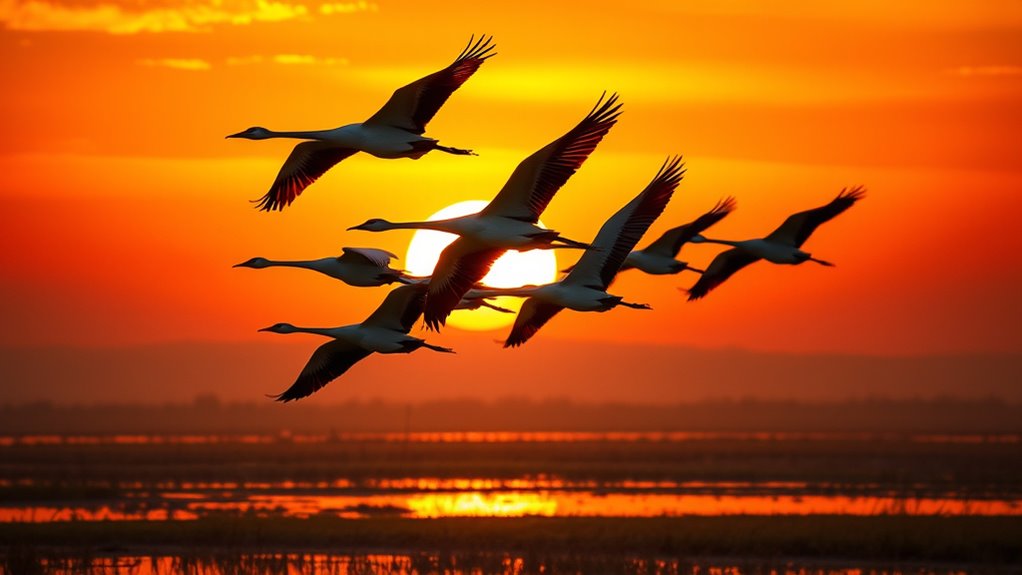Cranes in flight symbolize resilience, hope, and the natural cycles that stretch over a thousand years. They migrate across continents, connecting ecosystems and cultures with their graceful journeys. In many societies, cranes represent longevity, peace, and renewal, embodying a promise of enduring harmony. Their flight reminds us of the importance of preserving habitats and respecting nature’s rhythms. If you want to discover how these symbols protect our shared heritage, keep exploring their stories.
Key Takeaways
- The “1,000-year promise” symbolizes the enduring hope, longevity, and renewal associated with cranes in many cultures.
- Cranes’ migration patterns reflect resilience and the natural cycle of life, embodying a promise of continuity over generations.
- In Japan and China, cranes represent wisdom, patience, and everlasting harmony, reinforcing cultural commitments to environmental preservation.
- The long lifespan of cranes mirrors a commitment to future generations, symbolizing a promise of enduring peace and mutual respect.
- Conservation efforts inspired by the crane’s symbolic promise aim to protect habitats and sustain migration routes for centuries to come.

As cranes soar across the sky, their graceful flight captures the awe of anyone lucky enough to witness it. You can’t help but pause and watch as they glide in perfect formation, their long wings stretching wide against the blue. These majestic birds aren’t just beautiful; they carry deep significance rooted in migration patterns and cultural symbolism. Every year, they travel thousands of miles between breeding and wintering grounds, following ancient routes that have been passed down through generations. Understanding these migration patterns reveals more than just their seasonal movements — it connects you to a natural rhythm that’s been ongoing for centuries. They seem to follow a sense of purpose, a timeless instinct that guides them through landscapes and across borders, unifying ecosystems in a silent, soaring dance.
Cranes’ graceful flight unites nature’s rhythm with cultural symbolism across generations.
Their migration isn’t random; it’s a carefully orchestrated journey driven by instinct and environmental cues. As you observe them, you realize that each flight is part of a larger story—a story of survival, adaptation, and resilience. These patterns often align with seasonal changes, ensuring they reach suitable breeding sites in spring and abundant feeding grounds in winter. Their journeys can span continents, from breeding grounds in Siberia or Japan to wintering spots in places like China or Korea. Watching them navigate these lengthy routes, you sense the importance of preserving their habitats, as each stopover becomes a crucial link in their survival chain. Migration routes are often passed down through generations, emphasizing their significance in natural history.
Culturally, cranes symbolize more than migration. Across many societies, they embody hope, longevity, and renewal. In Japan, they are revered as mystical creatures that bring good fortune and peace. The image of a crane is woven into traditional arts, folklore, and even wedding ceremonies, representing a promise of fidelity and a long-lasting bond. In China, cranes symbolize wisdom and immortality, often depicted in paintings and sculptures. The 1,000-year promise you hear about relates to this deep-rooted symbolism — a vow of enduring harmony between humans and nature. It’s as if the crane’s long lifespan and graceful flight serve as a reminder of the importance of patience, respect, and the interconnectedness of life.
As you watch these birds in flight, you’re witnessing more than a natural spectacle. You’re observing a living symbol of continuity and hope, intertwined with cultural meanings that stretch across generations. Their migration patterns remind you that nature’s rhythms are timeless, and their cultural symbolism encourages you to honor these creatures as part of your shared heritage. Cranes in flight are a testament to resilience and tradition, inspiring you to protect these birds and keep their stories alive for many more generations to come.
Frequently Asked Questions
What Cultural Significance Do Cranes Hold Worldwide?
Cranes hold deep cultural symbolism worldwide, representing longevity, happiness, and good fortune. You’ll find them in traditional festivals across Asia, especially during New Year celebrations, where they symbolize renewal and hope. In many cultures, cranes are revered as sacred creatures and are believed to carry spirits to the heavens. Their graceful flight inspires art and folklore, making them powerful symbols of peace, wisdom, and enduring tradition.
Are All Crane Species Protected by Law?
You might wonder if all crane species are protected by law. While many species benefit from legal protections due to their declining populations, protection varies by region. Laws often focus on safeguarding crane migration patterns and habitats, emphasizing habitat restoration efforts. However, some species lack extensive legal protection, making conservation efforts essential. Supporting habitat restoration helps guarantee cranes continue their critical migration and breeding behaviors worldwide.
How Do Cranes Communicate During Migration?
During migration, you might notice cranes communicating through distinct bird vocalizations, which serve as migration signals. These vocalizations help cranes stay in contact, coordinate their flight paths, and alert each other to potential dangers. By responding to these sounds, you see how essential acoustic signals are for maintaining group cohesion and ensuring a successful journey, demonstrating the importance of communication in their seasonal migrations.
What Are the Main Threats to Crane Populations?
You should know that the main threats to crane populations are habitat loss and changes in migration patterns. As wetlands and breeding grounds shrink, cranes struggle to find safe places to rest and feed. Additionally, climate change disrupts their migration timing, making it harder to reach suitable habitats. These threats endanger their survival, so protecting habitats and understanding migration patterns are vital for their future.
Can Cranes Live in Urban Environments?
Like Icarus soaring towards the sun, you wonder if cranes can thrive in urban environments. They can adapt through urban adaptation, utilizing city nesting sites, and finding food in parks and wetlands. While not ideal, some crane species do manage to live and even breed in cities, showcasing resilience. Their presence reminds us that nature’s beauty can sometimes find a way in the most unexpected places.
Conclusion
As you watch cranes glide gracefully through the sky, remember their 1,000-year promise—an enduring symbol of hope and renewal. Though centuries may pass, their flight remains a proof to resilience and tradition. In their soaring, you see not just birds, but a future that’s rooted in the past. So, next time you witness their journey, feel the weight of history and the promise of tomorrow, intertwined in every graceful wingbeat.











